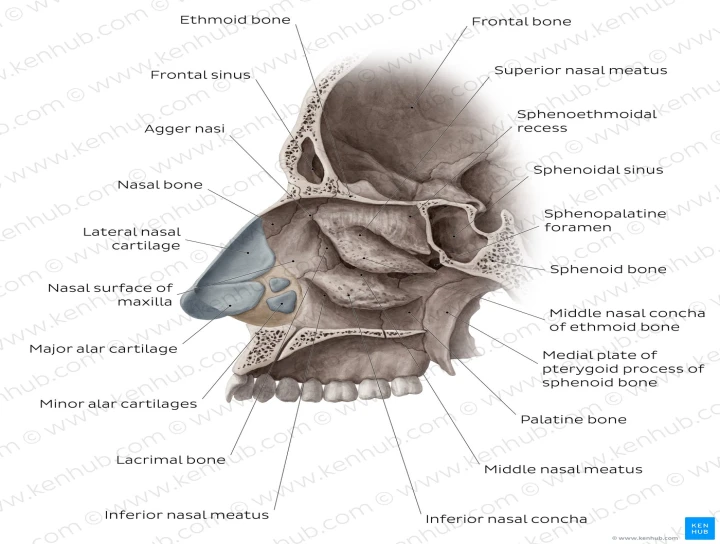
Evaluation of the Relationship Between Dimensions of the Maxillary Sinus Drainage System (Osteomeatal Unit) with Anatomical Variations and Sinusopathy
The maxillary sinus drainage system, primarily mediated by the osteomeatal unit (OMU), plays a critical role in maintaining sinus health. The OMU, a complex anatomical region, includes the maxillary sinus ostium, infundibulum, ethmoid bulla, and hiatus semilunaris. Any alteration in its structure or function can disrupt normal drainage and lead to sinus disease, or sinusopathy. Understanding the relationship between OMU dimensions, anatomical variations, and sinusopathy is essential for accurate diagnosis and effective management.
Maxillary Sinus Drainage and the Osteomeatal Unit
The OMU serves as the primary pathway for drainage of the maxillary, frontal, and anterior ethmoidal sinuses into the nasal cavity. Proper drainage relies on the patency and optimal size of the sinus ostium and surrounding structures. Narrowing or obstruction of the OMU due to anatomical variations or inflammatory conditions can result in impaired mucociliary clearance, predisposing patients to recurrent or chronic sinus infections.
Anatomical Variations and Their Impact
Several anatomical variations within the OMU region can influence sinus drainage, including:
- Deviated Nasal Septum (DNS): A common variation that may compress adjacent structures and impede airflow, contributing to sinus dysfunction.
- Concha Bullosa: Pneumatization of the middle turbinate that can narrow the infundibulum or sinus ostium, obstructing drainage.
- Haller Cells (Infraorbital Ethmoid Cells): These can encroach on the maxillary ostium, disrupting normal drainage.
- Uncinate Process Variations: Abnormal angulations or hypertrophy of the uncinate process may block the sinus ostium or alter the infundibulum.
- Paradoxical Middle Turbinate: A rare variation where the convexity of the turbinate faces laterally, potentially compressing the OMU.
Sinusopathy and Its Association with OMU Dimensions
Sinusopathy, including acute and chronic sinusitis, is often associated with OMU obstruction. Reduced dimensions of the maxillary ostium and infundibulum due to anatomical variations or inflammatory edema are frequently observed in sinusitis patients. Chronic sinusitis, in particular, is linked to persistent obstruction, leading to mucosal thickening, sinus cavity opacification, and the formation of mucoceles or polyps.
Imaging studies, particularly computed tomography (CT), have proven invaluable in evaluating OMU dimensions and anatomical variations. CT allows precise measurement of the sinus ostium and infundibulum and reveals structural anomalies contributing to sinusopathy. Such evaluations help in correlating radiological findings with clinical symptoms to determine the underlying etiology of sinus disease.
Clinical Implications and Management
Understanding the relationship between OMU dimensions, anatomical variations, and sinusopathy has several clinical implications:
- Diagnosis: Identifying structural abnormalities is critical for diagnosing chronic or recurrent sinusitis.
- Surgical Planning: Functional endoscopic sinus surgery (FESS) aims to restore normal drainage by addressing anatomical variations, such as widening the maxillary ostium or correcting a deviated septum.
- Prevention: Early recognition of predisposing factors allows for timely intervention, such as medical therapy or minimally invasive surgical procedures, to prevent progression to chronic sinus disease.
Conclusion
The dimensions of the OMU and associated anatomical variations significantly influence maxillary sinus drainage and the development of sinusopathy. A comprehensive understanding of these relationships through imaging and clinical correlation is essential for effective diagnosis, treatment, and prevention of sinus diseases. Advances in imaging techniques and surgical approaches continue to improve outcomes for patients with sinus disorders related to OMU dysfunction.


No Any Replies to “Evaluation of the Relationship of Dimensions of Maxillary Sinus Drainage System (Osteomeatal Unit) with Anatomical Variations and Sinusopathy”
Leave a Reply